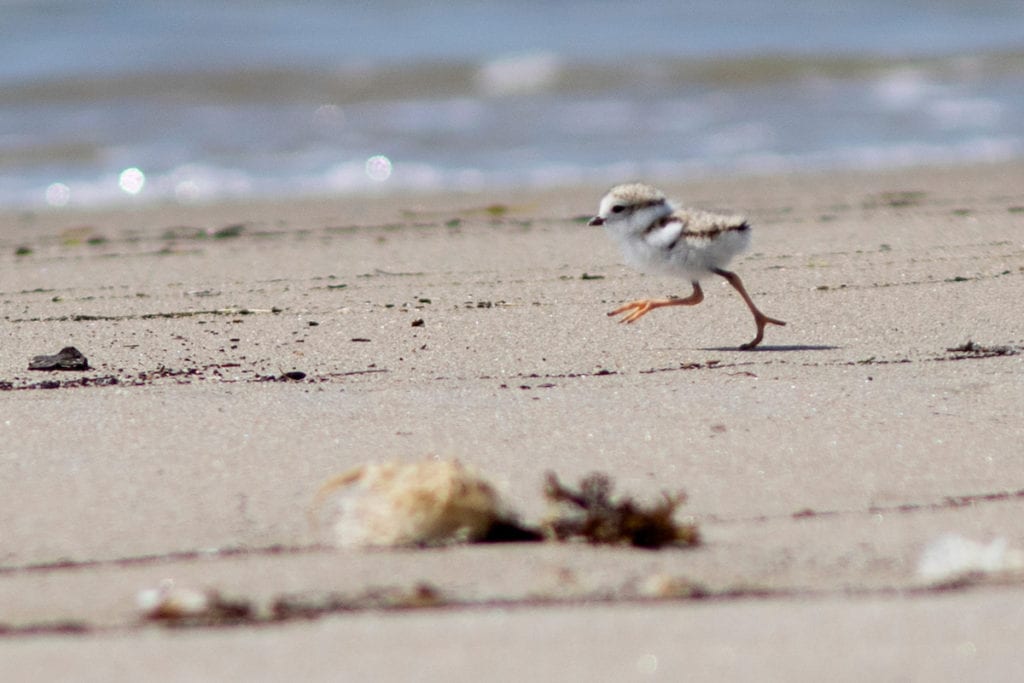
Exciting update from the coastal birds crew: On Monday, May 27, we saw the first Piping Plover chicks on one of our Maine beaches! Though no one was able to capture any photos from that day—the chicks are quite small, move around a lot, and are super fast—we are delighted at the prospect of chicks soon being all over our beaches. After weeks of finding new nests, putting up lots of stake and twine fencing, and exclosures, the field crew was thrilled to see chicks had hatched. (Exclosures are put up around specific nests to keep predators out, but still allow the plovers to come and go freely. Watch this video to see how it’s done!)
The crew is still focused on finding new nests and also looking out for hatching ones and keeping track of chicks, which is no easy feat! We would not be able to properly carry out these conservation efforts without the hard work and dedication of our volunteers and volunteer coordinators (VCs). Our volunteers are able to monitor bird activity during days and times when we are not able to be there. We keep a regular rotation of surveying beaches twice a week, while volunteers are out on their beaches every day. Volunteers report their findings to us through the VCs and we are able to use that information to help with everything from determining where fencing and exclosures are needed all the way to estimating hatch and fledge dates. The work they do on the beaches is vital to the success of our project.
We expect more chicks on the beaches in the coming weeks with a range of estimated hatch dates, so keep an eye out if you’re planning to hit any of the beaches in the coming weeks! It’s also important to note that the initial days and weeks after chicks hatch is a vulnerable time. Piping plover chicks are precocial, meaning they feed themselves and start moving around as soon as they hatch. They will be seen running around the beaches from the water line to the dunes, outside of fencing as they search for food and shelter. Cotton ball-sized chicks have been observed moving up to two miles! It is vital during this vulnerable period to take extra care to give the birds plenty of space.
Chicks will also freeze in response to threats (like humans!), and many people mistake this as an injured bird in need of help. It is of the utmost importance not to disturb the birds by attempting to pick them up or otherwise interact with them. We urge any beachgoers to pay close attention to leash laws and encourage pet owners to keep their animals off the beaches or on leashes to ensure the plovers’ safety throughout the season. New nests can still appear on Maine beaches through the end of June, so be mindful of nesting birds as well as adult birds chasing after their chicks.
We are also seeing more Least Tern colonies popping up on multiple beaches and have found tern nests and practice scrapes! This means we anticipate seeing tern chicks in the not too distant future as well.
Both the plovers and terns are quite fun to observe, and we ask that anyone wanting to watch them does so from a distance. It’s important to share the shore with our feathered friends and remind ourselves that the beach is their home, along with many other essential species. Each of these creatures are vital to the survival of the beach ecosystem and it’s important we all do our part to help maintain the beach and protect the wildlife. Take care when going and leave the beach better than you found it. Keep an eye out for updates from our blog and soon we’ll be announcing fledging chicks!
If you ever see something concerning on the beach, such as an unprotected nest, or a bird or chick believed to be injured, call our plover hotline at 207-245-2353.
More about the Coastal Birds Project >
Follow us on Instagram!
